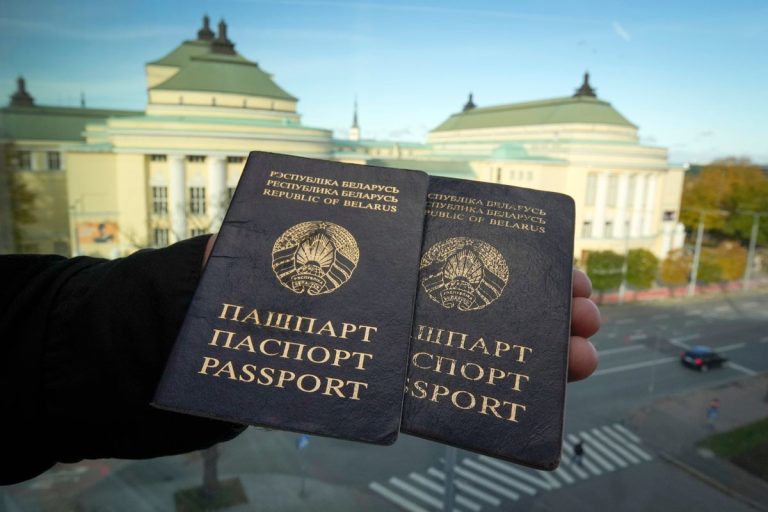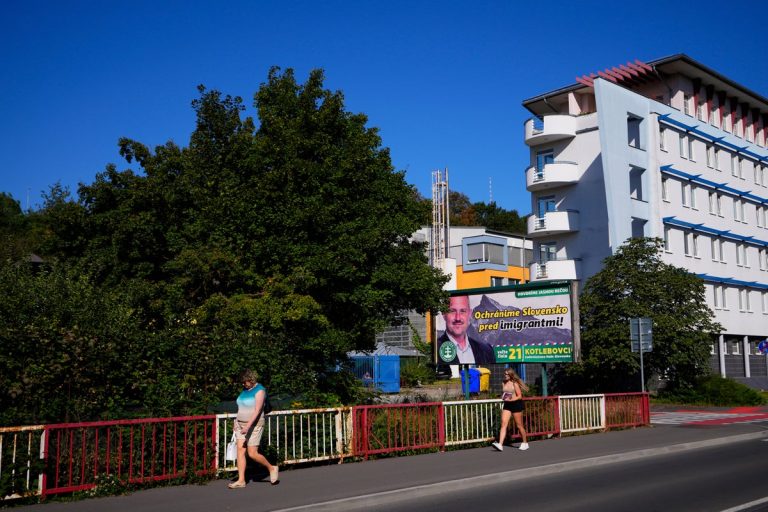‘When you say you are Roma, you have to work twice as hard’: Małgorzata Mirga-Tas, outsider at the heart of Polish art | Art and design

Małgorzata Mirga-Tas is the sort of person who hugs a visitor even before she says hello. She welcomes me into her home in the village of Czarna Góra, at the foot of the Tatra mountains in southern Poland, with a high-wattage smile. The artist’s house is right next to her aunt’s and her mother’s. The modern buildings huddle together, facing each other protectively round a flower garden. Mirga-Tas loves being close to so much of her family. “I go out of my house,” she says, “and drink coffee with my mother and my sister before I go to work.”
This morning her husband is making the coffee, there is a plate groaning with cake on the table, and her two teenage boys, it being the school holidays, are slumbering upstairs. Mirga-Tas is a member of Poland’s Bergitka (mountain) Roma community, who have been settled here for centuries. It’s not the easiest thing in the world for her sons to negotiate their identity, she says. “When you decide to say to everyone you are Roma, you need to be strong and you need to work twice as hard.”
Delightful as the setting is, it’s not exactly an idyll. The houses are next to a river that regularly floods. Her grandfather, who bought the land, was barred from purchasing a better position, just one example of a seemingly endless history of everyday prejudice faced by the Roma people. Mirga-Tas points to the building opposite, where her aunt used to run a nursery. It was great, she says, since she would get the young Romany-speakers used to Polish before they arrived at primary school. “The transition can be difficult,” she says. Because of the language gap, “people think that Roma children are stupid”.
Burgeoning career … inside Mirga-Tas’s studio.
Photograph: Róbert Németi/The Guardian
But the nursery got shut down by the authorities, she says. Many of the Romany community of Czarna Góra have found better prospects abroad. There’s a whole group of her family members in the UK, in Southend, on the Essex coast.
Mirga-Tas, through the vigorous clarity of her art, is a force for change
We drive a few miles to the village of Szaflary, where Mirga-Tas works. On the way, she reels off her plans. She has solo exhibitions in Seville and London this autumn, and a bewildering number of other commitments, including the project she is working on today: textile portraits for a local museum of the often overlooked female artists who worked in the nearby mountain town of Zacopane in the 20th century, when it was a magnet for Polish artists and musicians, including the composer Karol Szymanowski, all drawn to the glorious mountainous landscape.
Her career is burgeoning. Mirga-Tas leapt into the consciousness of the international art world last year when her work was included in Europe’s two most important contemporary art events: Documenta, which takes place every five years in Kassel, Germany, and the Venice Biennale, for which she represented Poland. She covered its lofty pavilion’s walls, floor to ceiling, with 12 gloriously detailed, sensuous, tapestry-like works – not of woven cloth but rather collages created from stitched-together secondhand clothing and other textiles, depicting scenes of Romany life and portraits of people in her community.
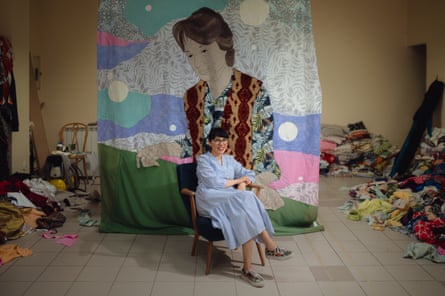 ‘The “expert” voice on the Roma is seen as more important than the Roma voice itself’ … Małgorzata Mirga-Tas and one of her recent works in her studio. Photograph: Róbert Németi/The Guardian
‘The “expert” voice on the Roma is seen as more important than the Roma voice itself’ … Małgorzata Mirga-Tas and one of her recent works in her studio. Photograph: Róbert Németi/The Guardian
The images were partly based on the frescoes in the Hall of the Months in Palazzo Schifanoia in Ferrara, northern Italy: 15th-century works of astonishing vitality that also inspired Ali Smith’s novel How to Be Both. The whole effect was dazzling – and also welcoming, sensuous – an oasis. “Cloth tents, fabric interiors, woven rugs, quilts and cushions have been our homes, our futures, our survival,” wrote Romany scholar Ethel Brooks in the exhibition’s accompanying book. “We have always built our mobile palaces as means of existence.”
To make this “palace”, Mirga-Tas and her helpers, including her aunt, took over the huge foyer of an empty hotel in Zacopane. They worked every day till midnight, from November to March, in the latter stages under the sense of fear and dread brought about by Russia’s invasion of Poland’s eastern neighbour, Ukraine. The pavilion was a huge hit – and it was notable that she was the first Romany artist to represent a nation state at the biennale, despite the Roma being the largest ethnic minority in the EU.
A double-edged sword, perhaps: the pavilion’s co-curator, Wojciech Szymański, told me that although Mirga-Tas was the obvious choice for the role, and the selection panel’s unanimous choice, some noted that showing a Roma artist was oddly convenient for the populist, rightwing, Law and Justice party-led government. It could present a progressive image abroad by promoting a Romany artist at this most prominent of cultural events – while Law and Justice presided, simultaneously, over a political climate far from friendly to the nation’s Romany population.
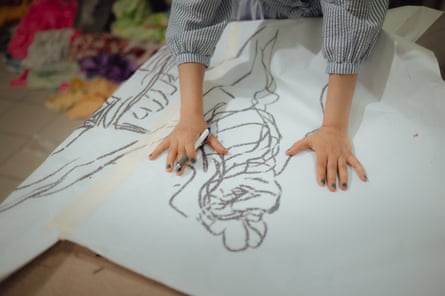 Mirga-Tas working on a new project in July this year. Photograph: Róbert Németi/The Guardian
Mirga-Tas working on a new project in July this year. Photograph: Róbert Németi/The Guardian
These days, Mirga-Tas is back in her own studio: a unit on an industrial estate on Szaflary’s outskirts. Its unprepossessing exterior gives way to a joyous kaleidoscope of colour inside: the room is heaped with piles of brightly coloured used textiles and old clothing. Next to the window, her seamstress-assistants Małgorzata Brońska and Halina Bednarz are stationed at their sewing machines. Mirga-Tas buys some of the used fabric and clothes – but a lot of them are cast-offs from her and her family, a nod to a deep history of her community’s thrifty adaptiveness, but also in tune with an environmentally conscious impulse to reuse and recycle. “People give us things, too,” she says. “There’s a lady who regularly brings us stuff of her own, and from her friends.”
At the Polish pavilion, her textile portraits often incorporated fabrics from the subjects’ wardrobes – so that, as British Romany author Damian Le Bas put it, they were somehow more than represented, they were semi-present in a kind of “supervised reincarnation”.
skip past newsletter promotion
Your weekly art world round-up, sketching out all the biggest stories, scandals and exhibitions
„,”newsletterId”:”art-weekly”,”successDescription”:”Your weekly art world round-up, sketching out all the biggest stories, scandals and exhibitions”}” clientOnly config=”{„renderingTarget”:”Web”}”>Privacy Notice: Newsletters may contain info about charities, online ads, and content funded by outside parties. For more information see our Privacy Policy. We use Google reCaptcha to protect our website and the Google Privacy Policy and Terms of Service apply.
after newsletter promotion
This morning, Brońska and Bednarz have been machining some of the last patchwork elements of a vast portrait of Barbara Gawdzik-Brzozowska, a painter and illustrator who lived in Zacopane until her death in 2011. Mirga-Tas hadn’t heard of her until the commission, but she has always liked the work of her husband, the more celebrated Polish artist Tadeusz Brzozowski, and she is fond of their son. One of her mother’s old dresses has been repurposed as Gawdzik-Brzozowska’s blouse in the portrait, which is a proper tribute: “I never normally use items like this for people I don’t know.” The brown patterned waistcoat is made from curtains from Zacopane’s Imperial hotel.
Mirga-Tas describes her process: she first makes drawings, often working from photographs, which are blown up by a printer to the required scale. She then uses carbon paper to transfer the drawings on to backing material, for which old hospital sheets work best. Then she selects and arranges the fabric and the sewing begins. For the faces, hands and legs she uses linen, which she paints.
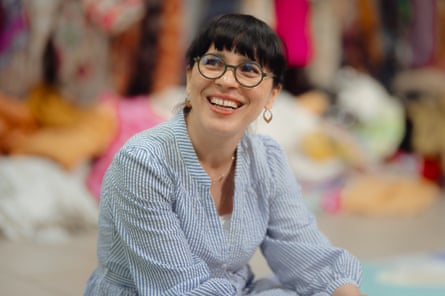 Force for change: Mirga-Tas in her studio in Szaflary, Poland. Photograph: Róbert Németi/The Guardian
Force for change: Mirga-Tas in her studio in Szaflary, Poland. Photograph: Róbert Németi/The Guardian
Mirga-Tas studied sculpture in Kraków – and thinks of these works, perhaps surprisingly, more as sculpture than as painting rendered in fabric. In 2016, one of her sculptures came to wide attention in Poland for the wrong reasons: a carved wooden memorial she had made in 2011, honouring 29 Romany people murdered in 1942 near the village of Borzęcin Dolny, east of Kraków, was seriously vandalised, an act that led to widespread outrage and appeals to the president for funding to restore it.
This was close to the bone for Mirga-Tas: one of her great-grandfathers was murdered in the Porajmos (“the devouring”, the Romany word for the Holocaust), along with 75% of Poland’s Romany people. That same year, she also made a piece of work that set her on her current path. Wesiune Thana (Place in the Woods) was an installation among the Romany houses in an open-air museum of rural culture at the Sądecki Ethnographic Park in Nowy Sącz, south-east of Kraków.
Between the little wooden buildings among the trees were structures, including a forge, that had been removed from her village, ones she remembered from her childhood. She draped them in bright, patchwork textiles – playing with the expectations of visitors for “colourful”, “ethnic” Gypsy flavours, as well as joyfully reclaiming and reviving the little houses. It was a pointed intervention into a long and fraught relationship between the Roma people and the discipline of ethnography. “We can speak in our own voice, but even now, the ‘expert’ voice on the Roma is seen as more important than the Roma voice itself,” she says. And yet Mirga-Tas, through the vigorous clarity of her art, is a force for change. She is speaking loud and clear in her own voice – and with authority.
Solo exhibitions of the work of Małgorzata Mirga-Tas are at Centro Andaluz de Arte Contemporáneo, Seville, Spain, 29 September to 31 March; and at Frith Street Gallery, London, until 11 November


